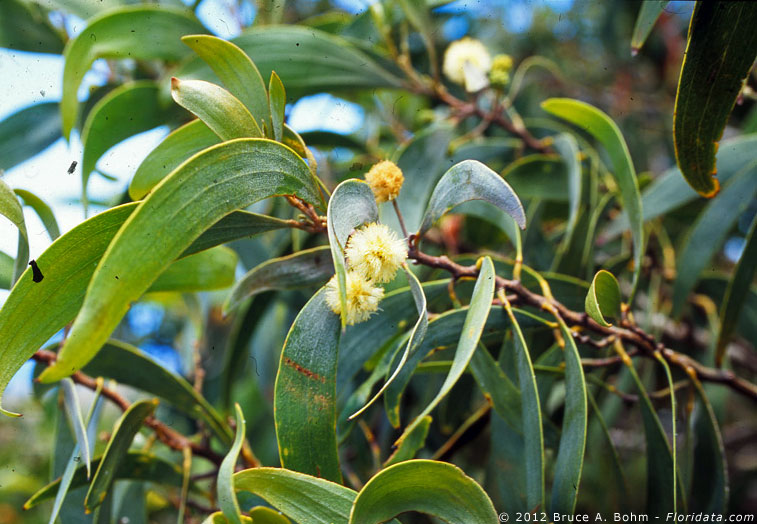



The next family, listed as Fabaceae in the Manual, or, following historical usage, Leguminosae by Mabberley (p. 474-477), is one of the largest families of flowering plants with 650 genera and about 18,000 species according to the Manual, or 720 genera with 19,500 species according to Mabberley. Regardless of the number, this is a truly gargantuan assemblage of organisms which enjoys a cosmopolitan distribution. The family is home to many plant species known to most readers: peas, beans, clovers, alfalfa, lupines, sweet peas, acacia, scotch broom, mimosa, indigo, lotus, gorse, and vetch, to mention only a few of the more commonly known members. The family is well represented in the Hawaiian Islands with 114 species in 50 genera. Fourteen species are endemic on the islands all but one of which belong to otherwise widely occurring genera. Of special interest in the story of the islands' legumes was the discovery of a previously unknown genus.
The flagship legume in the Hawaiian Islands is Acacia koa (see image), known most familiarly as koa. It was the most important tree for the islanders because it was out of its massive trunks that they built their sea-going canoes. Trees grew straight and attained heights well over a hundred feet. koa can be found on all of the main islands except Ni`ihau and Kaho`olawe and is frequently the dominant tree in an area. The choicest trees were from the Hana area of East Maui and from both the Hilo (eastern) and Kona (western) sides of the Big Island. In her 1998 book Hawaiian Heritage Plants, Angela Kay Kepler, a popular and prolific writer on Hawaiian natural history, described a canoe from Maui that measured 120' (37 m.) long and 9' deep–the canoe, not the tree! Trees this large are not easily found these days, if they exist at all. However, excellent specimens can be enjoyed by visiting the wild bird park, a kapuka on the Big Island near the beginning of the Mauna Loa access road. Additional groves of koa can be visited by driving a few kilometers along the access road, which leads eventually to an observation shelter.
An interesting feature of koa is the nature of its leaves. Juvenile leaves have the appearance of familiar highly dissected leaves (see image). As the tree matures, however, these young leaves are replaced by crescent shaped "leaves" that are not true leaves but rather structures that are called phyllodes. Phyllodes are thickened petioles that are different in origin but function like true leaves in their capacity for photosynthesis and respiration.
A visit to Pu`uhonua O Hanaunau (City of Refuge) on the Big Island's lee coast offers an excellent view into the lives of earlier islanders, and their utilization of koa.
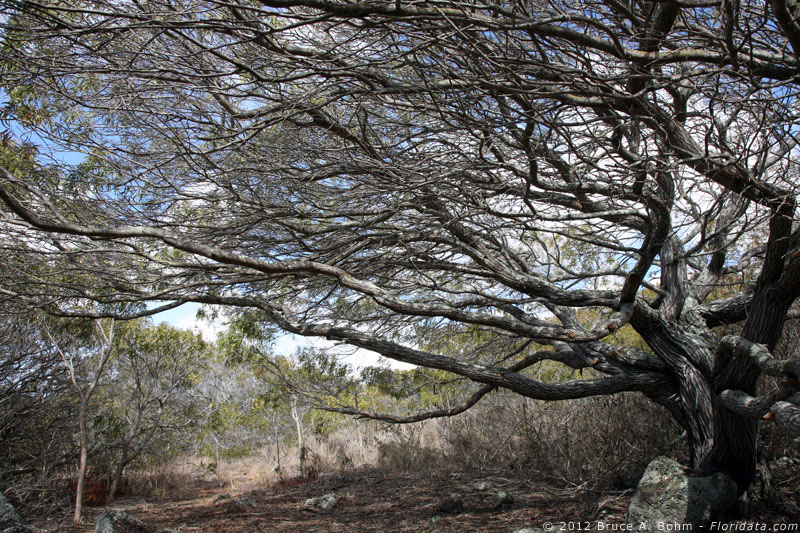
A second species of Acacia that may be overlooked by many visitors is Acacia koaia, which occurs in more open, drier habitats. These trees are smaller in stature, are more gnarled, and have much harder wood than A. koa. The photograph for this species (see image) was taken on the Big Island on the northwestern slopes of Mt. Kahala. Although much of the lee slope of Mauna Kea has been severely impacted by cattle ranching, small areas have been set aside, one of which, the Koa`ia Preserve, is open to the pubic. The preserve lies at about the 5.5 mile point on Highway 250 north of Wai`aka (just west of Waimea). This species also occurs in similarly dry habitats on Moloka`i, Läna`i, and Maui.
Worldwide, Acacia is a very large genus with as many as 1,075 species with the vast majority of them, perhaps 1,000, native to Australia (Mabberley, p. 3-4). With this many species in the genus, the question as to where the Hawaiian koa, or its ancestor, came from is an intriguing one. The question was addressed by Sherwin Carlquist–recall his seminal contribution to the silverswords–in his 1980 book Hawaii, a Natural History. He pointed out that the most closely related species, based on morphological similarities and their shared tetraploid chromosome number (double the normal complement of chromosomes), is A. heterophylla from Mauritius, which lies east of Madagascar in the Indian Ocean. Authors of the Manual suggest that the Mauritian and Hawaiian species may both be descendants of an Australian species such as A. melanoxylon. It was also pointed out by Carlquist that the Mauritian and Hawaiian species have seeds that float. An Australian, or southwestern Pacific, ancestry of elements of the Hawaiian flora is by no means an unprecedented suggestion. Many Hawaiian plant groups have connections with that source; whether they got to the islands by chance flotation or whether they traveled by the island-hopping route must remain matters of speculation, at least until more definitive information on relationships becomes available.
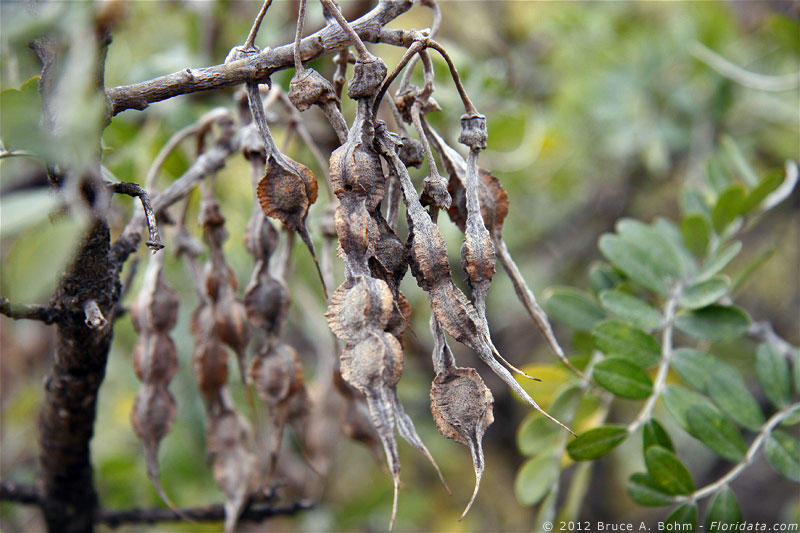
One of the most beautiful Hawaiian legumes is the mämane, Sophora chrysophylla (see images). Mämane is a major element of the subalpine vegetation of East Maui (Haleakalä) and the Big Island, although it does occur on all of the other main islands except Ni`ihau and Kaho`olawe. The golden yellow flowers are readily visible, and the twisted seed pods (see image) are also an attractive feature of the species. Freshly shed seeds are shiny orange.

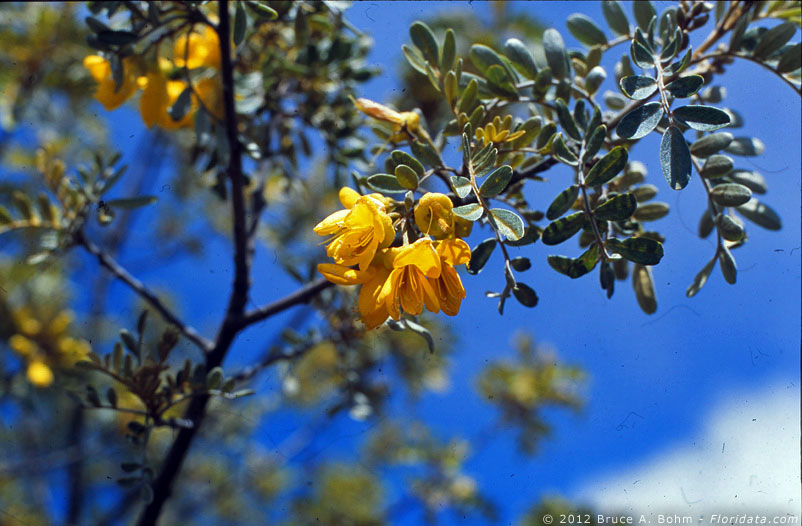
Authors of the Manual nominate the New Zealand species S. tetraptera as a possible close relative; experimental data are required to test this hypothesis. There are about 50 species of Sophora known one of which, S. toromiro, has an unusual place in Pacific islands botany (Mabberley, p. 807). This species was endemic on Rapa Nui, known more commonly as Easter Island, but, owing to its being over-harvested as a source of building material for dwellings and canoes, had been reduced to a single tree by 1917. The Norwegian explorer Thor Heyerdahl visited the island in 1955-1956 during which time he collected seeds from the remaining tree, which by 1962 had itself become the victim of grazing animals. More information on the taxonomic history and challenges to cultivation can be found at the Royal Botanic Garden, Kew website (see www.kew.org).

The genus Sesbania is represented on the islands by two species, the weedy S. sesban, Egyptian rattlepod; and the endemic S. tomentosa, whose local name is `ohai (see image). This beautiful legume was at one time widely scattered on all of the main islands, as well as on Necker and Nihoa of the northwestern islands. Owing to the disappearance of suitable habitat through commercial development, this species occurs in only a few locations at the present time. The photograph was taken on the north coast of Moloka`i in a small garden devoted to maintaining rare and/or endangered species. Very healthy specimens were also maintained at the headquarters of the Nature Conservancy on Moloka`i.
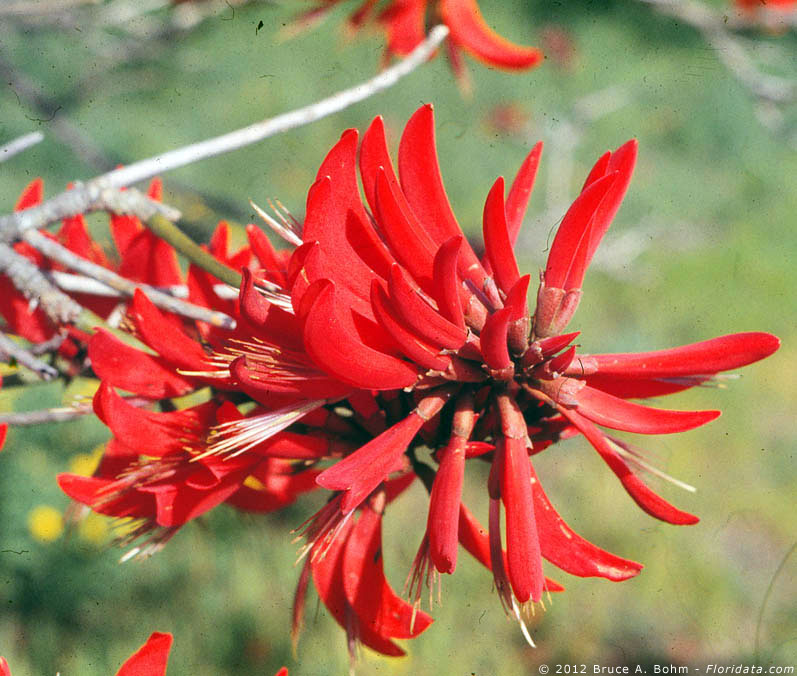
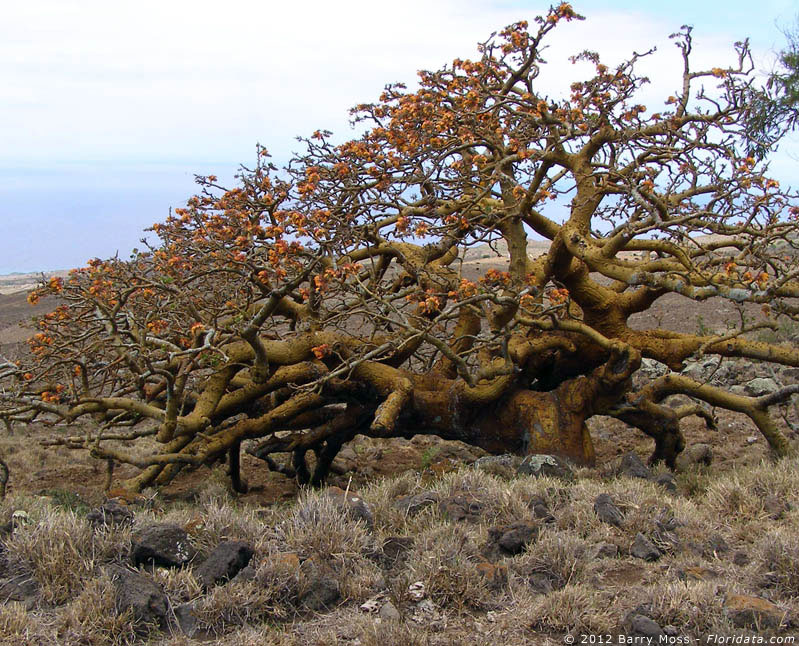
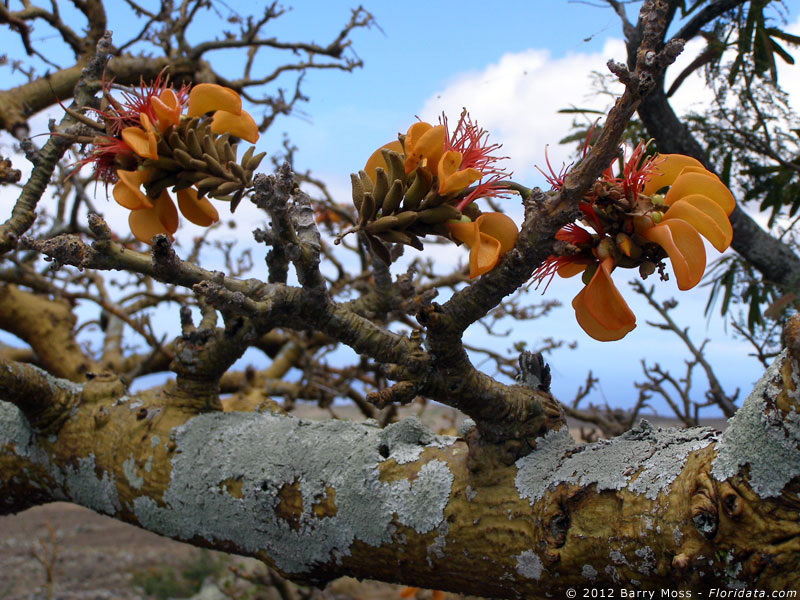
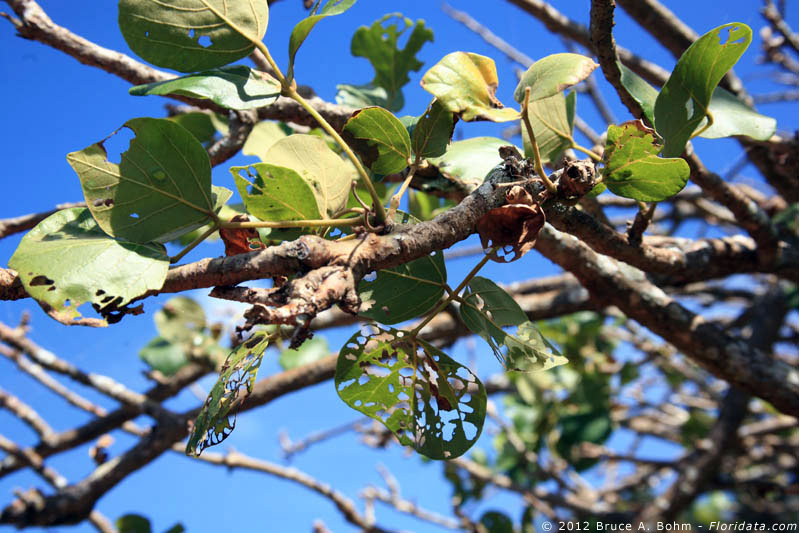
Erythrina is a genus of about 120 species from warm and tropical habitats with species known from Asia, Australia, Africa, Madagascar, and the Americas. The beautiful flowers of many species of Erythrina make it a popular source of decorative trees, the tiger claw or Indian coral tree for example (see image). Several species occur in the Hawaiian Islands although only one of them is native, Erythrina sandwicensis, known in Hawaiian as wiliwili (see images). Other members of the genus in the islands include decorative species from Asia (E. variegata) and South America (E. crista-galli); these species do not appear to have become naturalized. In addition to being very attractive, wiliwili provided, and continues to provide, wood used in canoe building, especially outriggers, and for making surfboards (the wood is lighter than koa, so the boards are lighter). Also available for show and purchase at the Canoe Festival (see above) were surfboards, papa he`e nalu in Hawaiian, some of which may have been wiliwili (Erythrina) wood or possibly koa. Wiliwili seeds are used in making leis, and preparations from flowers have been used medicinally.
But there is trouble in wiliwili land. On April 19, 2005 a gall wasp, Quadrastichus erythrinae, was first collected in Mänoa, O`ahu and within a matter of months was found throughout the state having been collected on the Big Island, Kaua`i, and Maui in July, on Moloka`i in August, and on Läna`i and Kaho`olawe in October (data from Department of Agriculture New Pest Advisory, Feb. 2006). This invader, which is more easily referred to as the erythrina gall wasp (EGW), was only described in the literature in 2004 from specimens collected from Singapore, Mauritius, and Reunion. Since then it has spread throughout southeastern Asia and to the islands of the Pacific. An infected wiliwili tree was photographed on the grounds of the NTBG in the spring of 2009 (image). Normally at that time of the year the tree would have fully greened foliage.
Because the attacking organism has only recently been identified, very little of its basic biology is known, which makes decisions on counter measures, such as how infestations can be prevented, or at least brought under some level of control, very difficult. Broadly acting insecticides are available but their use is plagued by the risk of doing injury to desirable insects. The ideal approach is to employ a natural enemy of the invading pest, which also carries the risk of attacking natives. Several parasitic wasps collected in Africa have been tested for their possible use in the Hawaiian Islands. A promising candidate has been found; Eurytoma erythrinae, a native of Tanzania, was reared by state entomologists and 500 of them (the wasps, not the entomologists) were released in late November of this year in the Lili`uokalani Botanical Gardens in Liliha, Honolulu. According to a report in the Honolulu Star Bulletin of November 28th, the wasps immediately began laying eggs. By July 2009 3,840 adult wasps had been released at field sites on Kaua`i, O`ahu, Moloka`i, Maui, and on the Big Island. It is too soon to evaluate effectiveness of this animal. Since it is never certain that a single natural enemy will be effective in a new setting, a second wasp, a species of Aprostocetus, is currently undergoing screening tests under controlled conditions. If this organism is deemed safe, it will be released for field tests later in 2009 (Yalemar et al., 2009).
From the Bishop Museum ethnobotany data base we learn that: "Pua ka wiliwili nanaku ka mano; pua ka wahine u`i nanaku ke kanawai," which tells us that when the wiliwili blooms, the shark (mano) bites, but when a beautiful woman (wahine u`i) blooms, the law bites. It's the old story: young men (the sharks) fighting over a beautiful woman requires the law (kanawai) to keep things from getting out of order. Supposedly, the flowering time of Erythrina occurs coincidentally with aggressive shark behavior. A serious investigation of this phenomenon is obviously overdue; volunteers are needed.
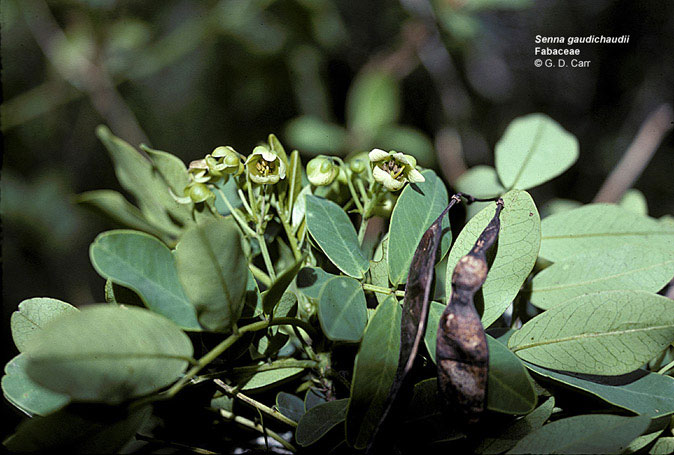
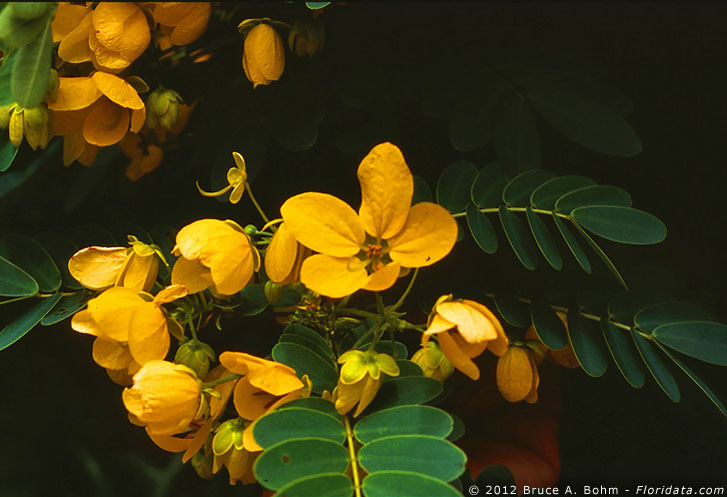
The genus Senna is represented on the islands by eight species seven of which are naturalized. The other is the indigenous S. gaudichaudii (see image), which is widespread on islands in the Pacific Basin. Hawaiian names for this species are kolomona and heuhiuhi and spelling variants. In the Hawaiian Islands it occurs in a variety of low to mid-elevation sites, sites that are often disturbed and dominated by alien vegetation such as Leucaena (koa haole) and Prosopis (mesquite), both of which will be described below.
Our representative from the non-native species is S. surattensis (see image), also called kolomona or kalamona in Hawaiian. The dark yellow flowers make this plant attractive to gardeners. For readers who are familiar with the Fabaceae, some members of this genus have at one time or another resided under the name Cassia.
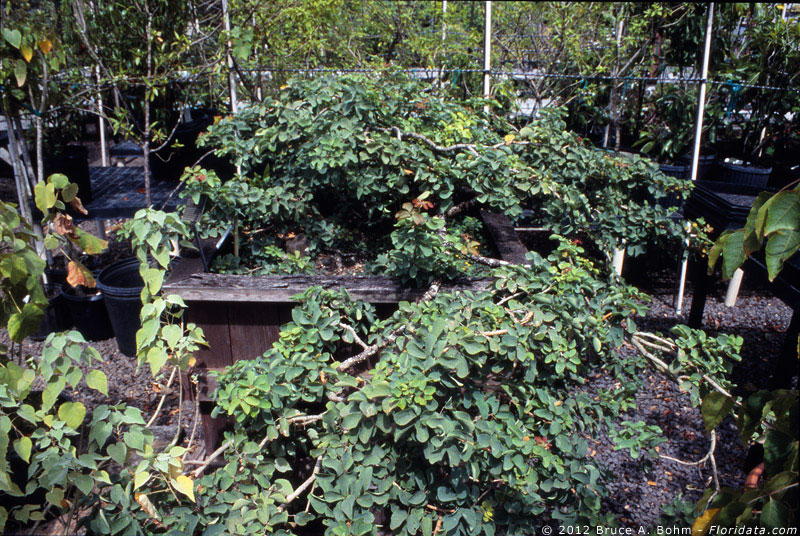

Perhaps the most remarkable example from this family is one of the newest and most exciting discoveries in contemporary Hawaiian botany. In 1992 Ken Wood and Steve Perlman, botanists at the NTBG, discovered two plants growing on a 3-acre sea stack, named Ale`ale Pu`uloae in Hawaiian, off the southern coast of Kaho`olawe. One of the plants growing there was eventually identified as belonging to a hitherto unknown genus. The name assigned by D. H. Lorence and Ken Wood (1994), the workers who submitted the formal identification, was Kanaloa kahoolawensis wherein the genus name recognizes Kanaloa, one of the four major Hawaiian (Polynesian) gods (the others were Käne, Ku, and Lono). The God Kanaloa was closely associated with sea voyaging. The specific epithet is the Latinized form of the island Kaho`olawe. The plant and close-up photographs (see images) were taken at the NTBG. Interested readers may with to visit the Offshore Islet Restoration Committee's (OIRC) site and navigate to Kaho`olawe where it is possible to examine photographs of the islet and some of the plants found there including Kanaloa. The OIRC site address is: www.hawaiioirc.org/OIRC-ISLETS.htm.
Although the new species is limited to the islet it is likely to have existed on Kaho`olawe as well, but its life there was threatened by feral goats, which of course, can't get to the islet. Pollen from the new species is very similar to unidentified pollen discovered in corings taken on O`ahu, Maui, and possibly Kaua`i (Burney et al., 2001; Burney, 2010) suggesting a much wider range of existence of the new species at some time in the past. It was co-dominant in pollen samples with the currently widespread Dodonaea viscosa (Sapindaceae) and a species of Pritchardia (a palm) during the time period 1210 BC to 1565 AD.
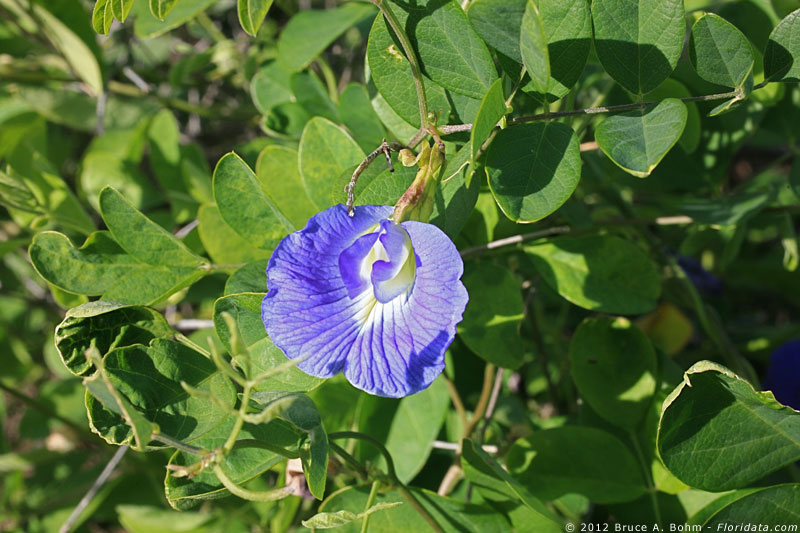
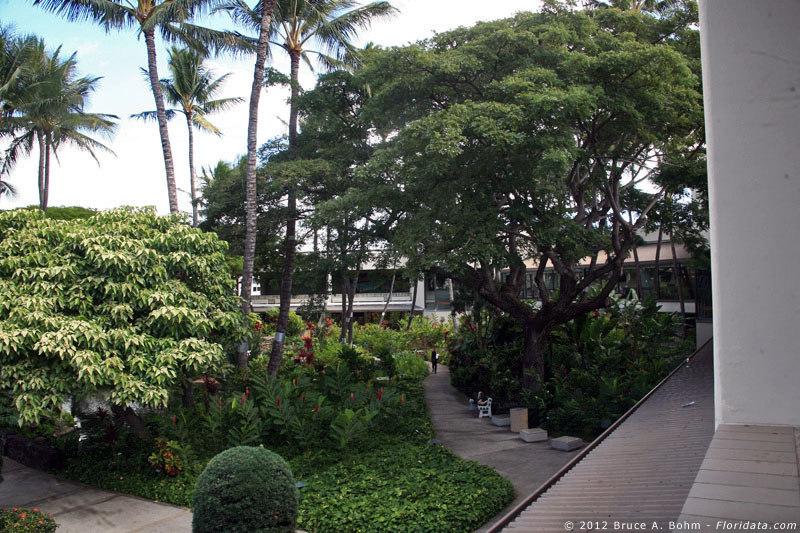
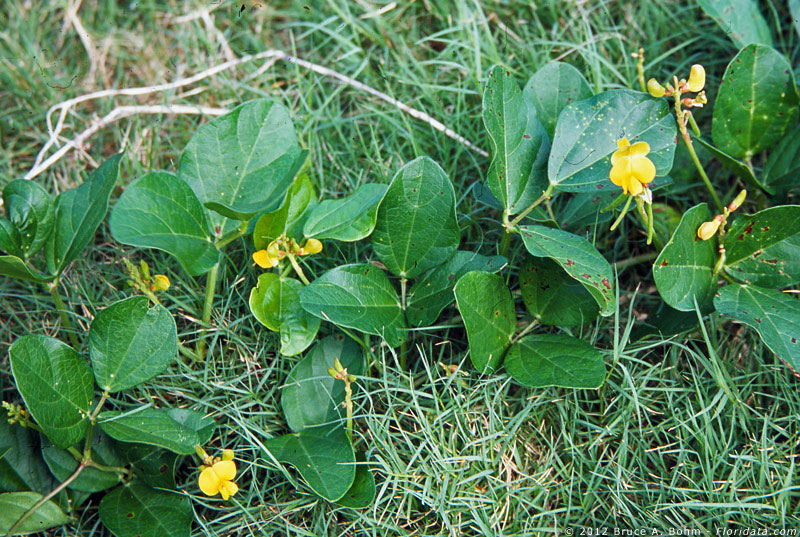
Difficulties in propagating Kanaloa arise from the fact that it is self incompatible. Other methods of propagation have been tried, but I am unaware of any successful outcome.
Many legumes have escaped cultivation in the islands, or gained access to suitable habitats as contaminants, and have spread widely. Most of these have not become significant pests (yet); some are actually quite attractive. One of the latter, and one of the few blue-flowered plants that one is likely to encounter in the islands, is Clitoria ternatea (see image), a neotropical species favored as a decorative plant but now escaped from cultivation.
The photograph was taken on the northern, dry slopes of Läna`i where this attractive legume was growing intermixed with the native Hawaiian cotton, ma`o, Gossypium tomentosum (more on cotton below in the section on Malvaceae).
One of the most impressive trees that visitors see in the islands is the rain tree or monkey pod tree, or, in Hawaiian `ohai or pü `ohai. This is Samanea saman, a popular shade tree that is native to the New World tropics.
Specimens can be seen in the Japanese Garden in the Honolulu International Airport (see image); equally impressive trees grow on the grounds of several holiday resorts on Kaua`i's southern coast, e.g. Kiahuna Plantation in the Po`ipu area. The flower of this species is particularly attractive (see image).
The genus Canavalia is represented on the islands by six endemic and two naturalized species; one of the latter is the weedy Canavalia cathartica (see image).
Two invaders from the Neotropics are Chamaecrista nictitans (see image), known as the partridge pea in English, or laukï in Hawaiian; and Macroptilium atroprupureum (see image), with one of the most intensely pigmented flowers known. And who doesn't enjoy tickling a sensitive plant? The first image (below) shows the undisturbed Mimosa pudica; the next a few seconds later after it had been disturbed.
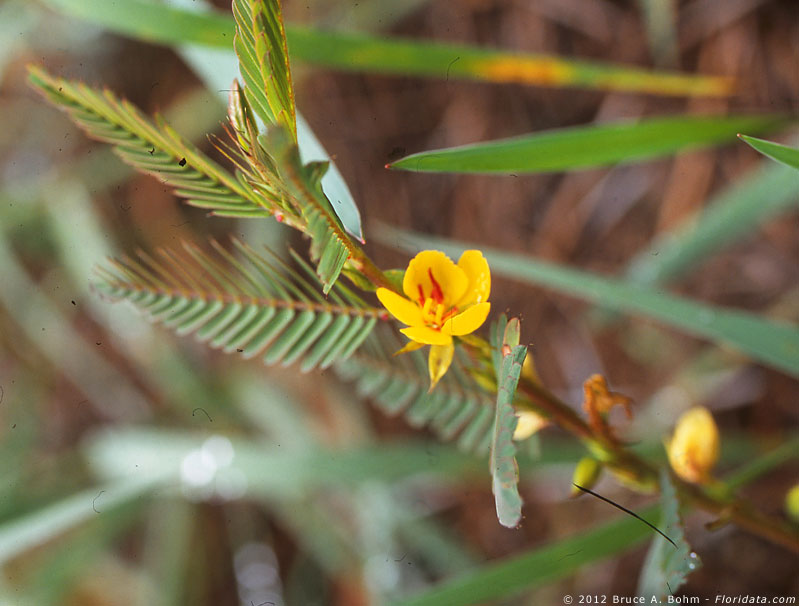
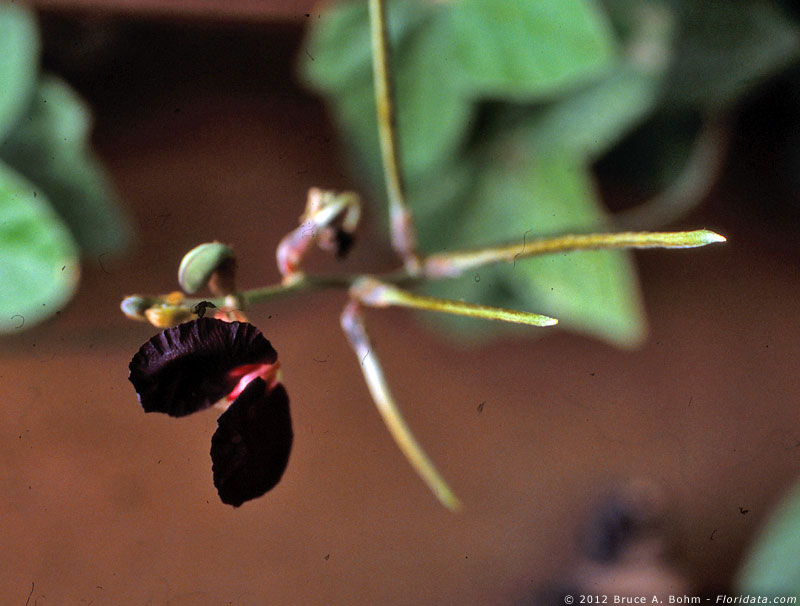
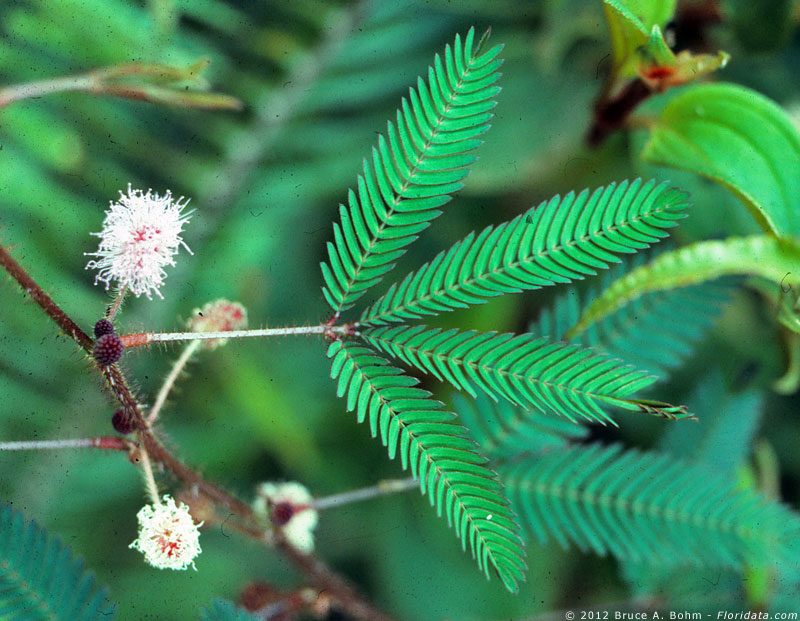
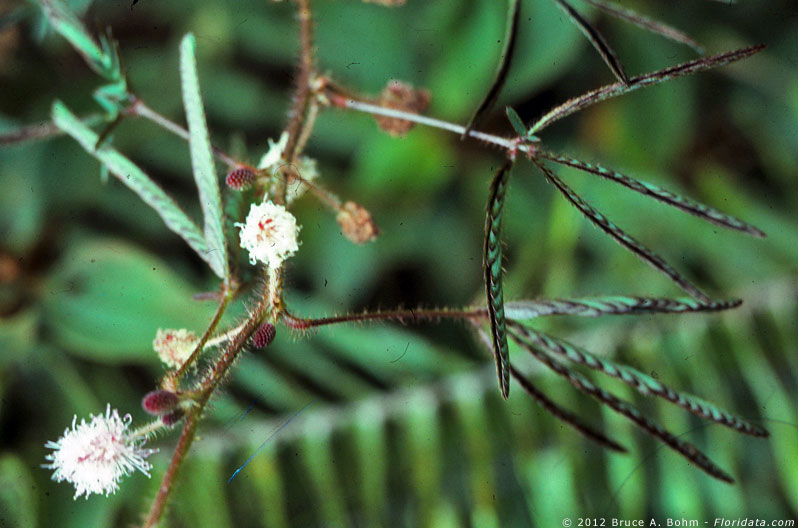
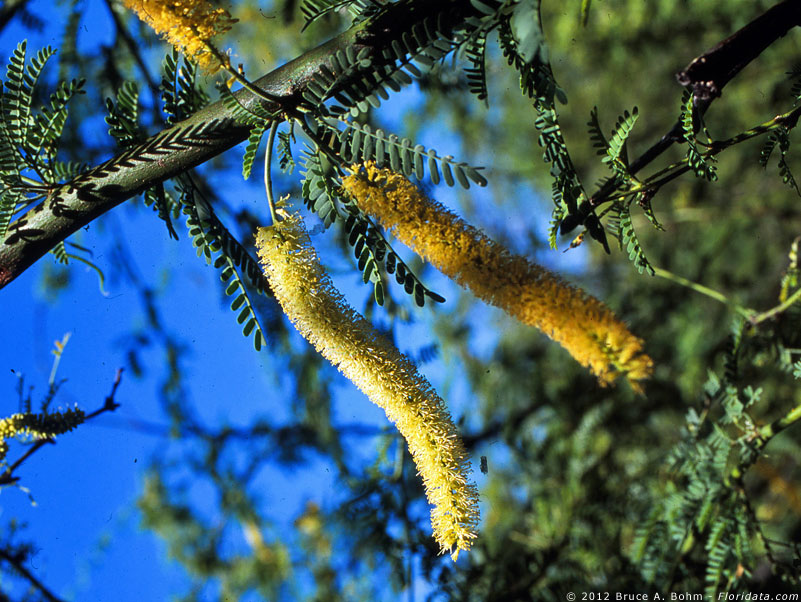
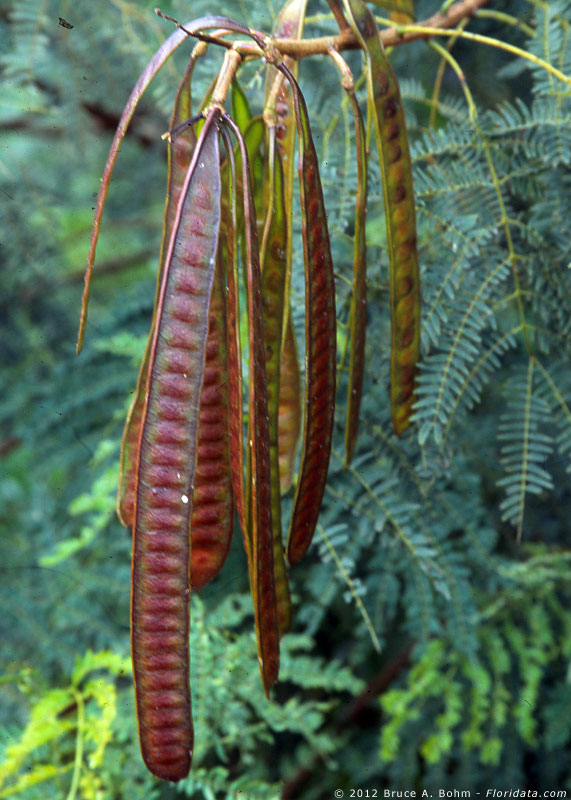
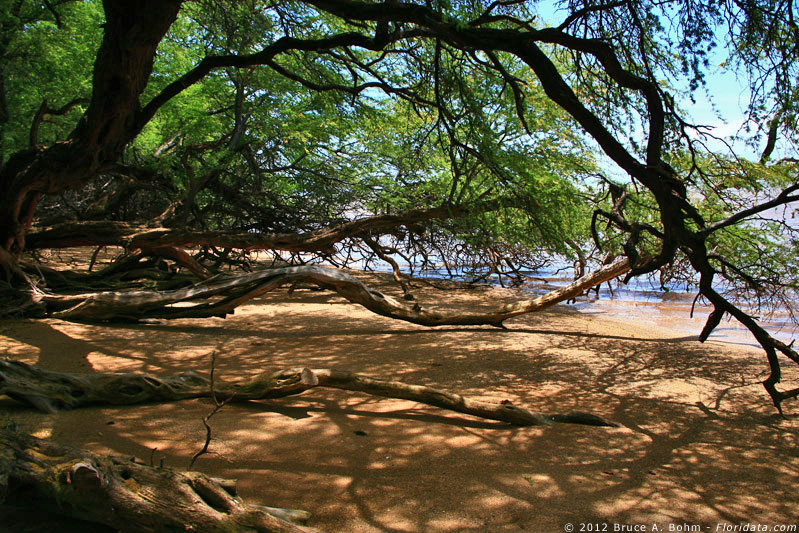
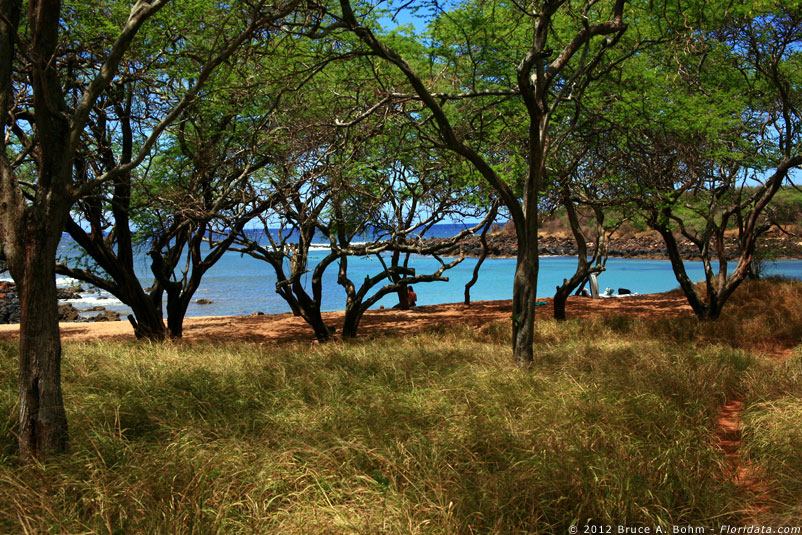

Three naturalized legumes are so widely distributed and are present in such abundance as to suggest that they are part of the natural flora. Nothing could be further from the truth. They are Prosopis pallida, kiawe or mesquite; Leucaena leucocephala, koa haole, which translates as foreign koa; and Paraserianthus falcataria. All of these could be considered troublesome although this view would not be shared by all, since all three are seen as useful by many people. We will look at each in turn.
Kiawe, or mesquite (see images), was introduced to the islands in 1828 by Father Bachelot who planted a single seed on the Catholic Mission grounds in Honolulu that he had obtained from the Royal Gardens in Paris. It is thought that all trees in the islands are derived from that single seed. It would be interesting to see if any genetic information could be generated that might shed light on this interesting situation, certainly a major genetic bottleneck event if it is true. The species is native to South America and, besides the Hawaiian Islands, has become naturalized in Puerto Rico and in Australia. The seed meal of kiawe is very nutritious and was favored fort use as an animal food. In the early part of the 20th century people in the islands collected pods of kiawe, for which they were paid 15 cents for a 35 pound sack. Some 90,000 pounds were collected annually and used for cattle, horses, mules, and pigs. As the authors of the Manual note in their discussion of this little piece of agricultural history, this was a sure way of getting seeds widely distributed.
Kiawe grows quickly and overshadows other plants preventing any competition. With its very deep root system it is also very efficient in utilizing available water which adds to its competitive superiority. Kiawe often forms dense thickets ranging from just above the vegetation line along beaches (see images) ranging to dry gulches and forests inland. The two sets of trees in those illustrations were in sheltered areas on southern and western beaches. A very well developed wall of kiawe can be visited on the north coast of western Moloka`i through which a cave-like passage way has been cut in the trees on the path to the dunes (see image). These trees owe their much shorter and gnarled growth form to the constant wind from the north and northeast–depending on the season–to which the area is subjected.
Attempts to remove kiawe is met with resistance from bee keepers who favor the honey produced from its copious crops of flowers. It is not an uncommon phenomenon to find conflicting interests of this sort. Many of the aggressive species that we have been dealing with were originally brought to the islands because of their attractive foliage or flowers, or, as we will see in the case of strawberry guava, the production of edible fruit. These issues of conflicting values can play serious roles in determining management programs for invasive species.
A second species of Prosopis, P. juliflora, commonly called long-spine kiawe, another visitor from the Neotropics, was reported in the islands in 1978. Whether it was an intentional or accidental introduction is unknown; the plant does have forage value. As its common name suggests, it differs from kiawe in having much longer spines, 2.5 inches (6 cm) compared to the inch-long (or absent) spines of kiawe. This plant tends to form thickets and spreads quickly. Its spines are potentially dangerous in that they are long enough (and sharp enough) to penetrate light foot ware and vehicle tires. Its presence on Kaua`i and O`ahu concerns invasive plant committees; it is also present on Moloka`i but is not thought to be a problem there. I am aware of at least one active removal program on Kaua`i.
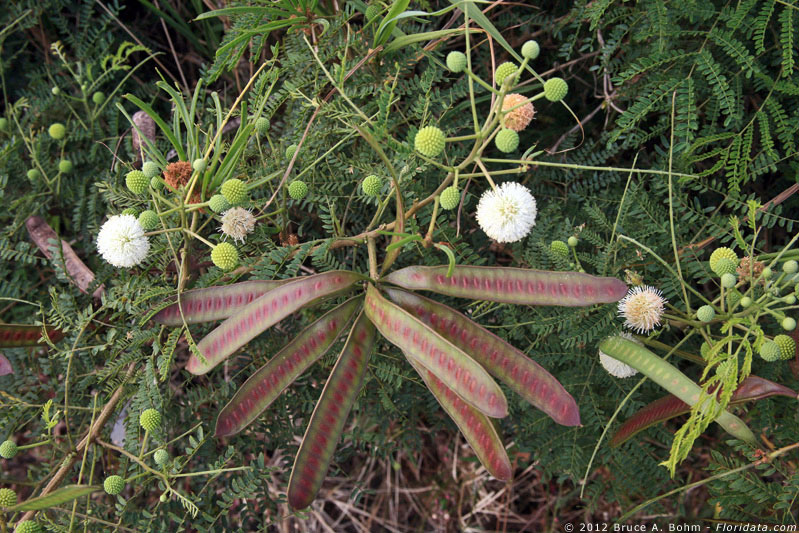
Leucaena leucophylla (see image), called koa haole (foreign koa) in Hawaiian because of the similarity of its flowers to those of Acacia, was first recognized in the Hawaiian Islands in 1837. It is native to the Neotropics but has been widely planted because of its several uses and has become naturalized in many places, including the Hawaiian Islands. The plant has been used to provide shade in coffee plantations, as a soil stabilizer, as a source of fire wood, and as a forage plant. Koa haole is a rich source of protein but its use as a forage plant must be controlled owing to the presence of a small percentage of the amino acid mimosine in the leaflets. Excessive amounts of this compound can lead to variety of problems in cattle including hair loss and neurological problems. To avoid this, and related effects on animals, koa haole should constitute only a portion of their diet.
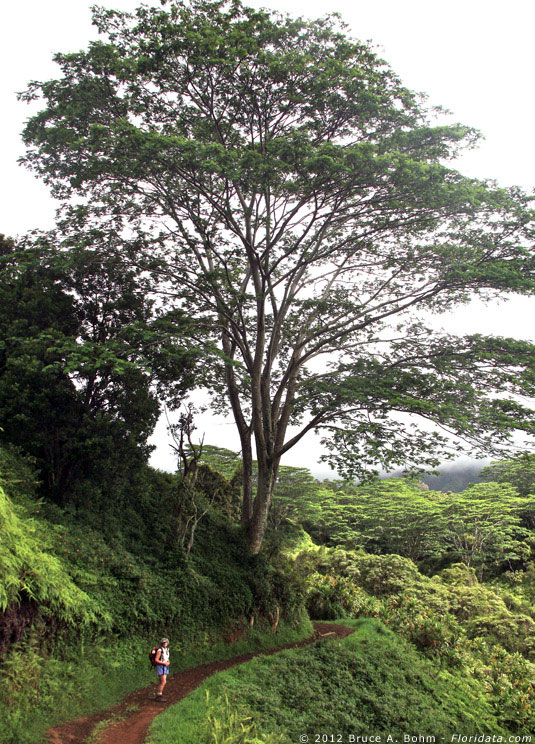
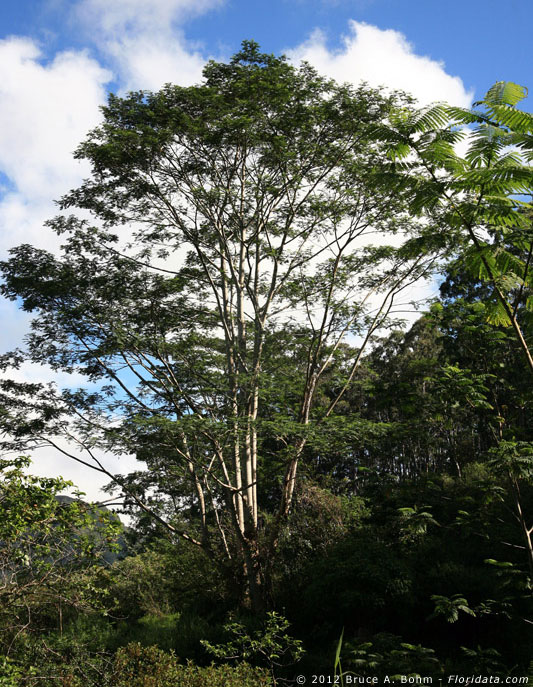
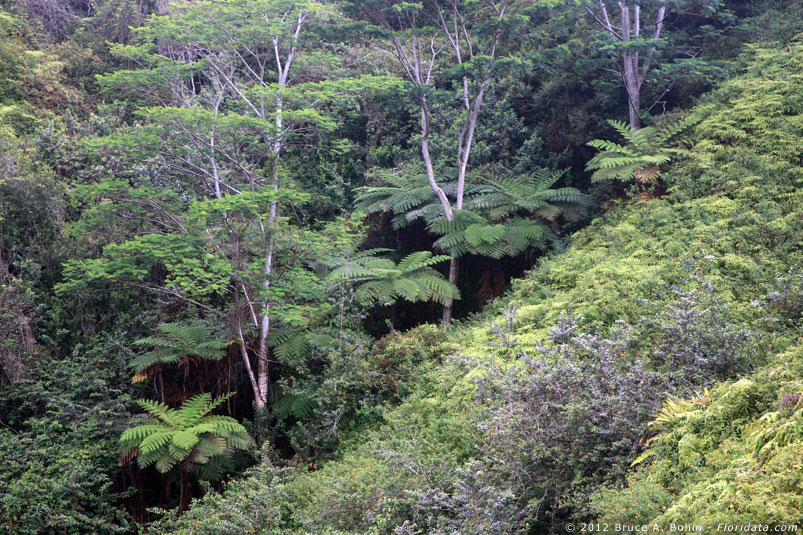
Undesirable features of koa haole include its capacity to form dense thickets that prevent germination and growth of native species. It burns well but regenerates quickly after fire. It occurs on all of the main islands including Läna`i where it played an interesting part in the behavior of another visitor (Hobdy, 1993). It became evident in the 1970s that the population of goats on the island was having a serious effect on the forested watershed and that something needed to be done. A concerted effort was mounted to eradicate goats, which by 1981 proved to have been very successful, too much so in fact. Removal of the goats relieved competition so that the axis deer population soared (axis deer had been introduced to provide hunters with targets). Migration of axis deer into the mountains was hastened by the attack of the Leucaena psyllid (Heteropsylla cubaba) on koa haole, a defoliating insect, which deprived the deer of their lowland food source. The situation became even more critical when it was learned that the deer were capable of climbing steeper slopes than was originally thought possible. This, in turn, resulted in increased erosion. A government census of 1988 determined that the number of deer on the northern half of the island was at least 3,700. Removal efforts were accelerated and continue to date, but axis deer are still present on the island.
The next example is listed under Paraserianthes falcataria in the Manual, but there are several other names that have been attached to this tree over the years in attempts by botanists to find its 'proper' place in the family: Albizia falcata, A. falcataria, A. moluccana, Adenanthera falcataria, and Falcataria moluccana. A convenient source of information on this species is the HEAR (Hawaiian Ecosystems at Risk) database, which lists it under F. moluccana. The link for that site is: here. One of the common names used for this tree is Molucca albizia (HEAR); others simply call it falcataria. The term 'falcate,' upon which some of these names are based, comes from the Latin for 'curved like a sickle' in reference to the curved shape of the leaflets.
Three examples of mature trees were photographed on a recent hike along the Kuilau Trail on eastern Kaua`i (see images). The tree grows very quickly and often occurs in sites where removal would be difficult as seen in the illustration where it is sharing a deep valley with the equally aggressive Australian tree fern Sphaeropteris cooperi (syn. Cyathea cooperi). Although graceful and elegant in appearance, mature trees can be dangerous insofar as they tend to shed entire limbs in moderate to heavy wind storms.
The species is native to Indonesia, Papua New Guinea, and the Solomon Islands. It is a fast growing tree, up to 15 ft (4.5 m) per year, that can reach a height of 130 ft (40 m).I have seen it called " southeast Asia's growth champion" . It was introduced to the Hawaiian Islands in 1917 and planted on several islands over the following years, but Maui received the bulk, at least 140,000 trees. Among the many uses are for shade for coffee plantations, for timber, or just because it is an attractive tree that does well in marginal soils. It does tend to spread into abandoned fields, however, and is considered as a potentially noxious weedy species.
Literature cited…
Carlquist, S 1980. Hawaii, a natural history. Pacific Tropical Botanical Garden, Läwa`i, HI.
Burney, D. A., H. F. James, L. P. Burney, S. L. Olson, W. Kikuchi, W. L. Wagner, M. Burney, D. McCloskey, D. Kikuchi, F. V. Grady, R. Gage II, and R. Nishek. 2001. Fossil evidence for a diverse biota from Kaua`i and its transformation since human arrival. Ecological Monographs 71: 615-641.
Burney, D. A . 2010. Back to the Future in the Caves of Kaua`i. A Scientist's Adventures in the Dark. Yale University Press, New Haven, CN, p. 128. Hobdy, R. 1993. Läna`i–A case study: the loss of biodiversity on a small Hawaiian Island. Pacific Science 47: 201-210.
Hobdy, R. 1993. Läna`i–A case study: the loss of biodiversity on a small Hawaiian Island. Pacific Science 47: 201-210.
Kepler, A. K. 1998. Hawaiian Heritage Plants. University of Hawai`i Press, Honolulu.
Yalemar, J., C. King, L. Kaufman, W. Nagamine and D. Oishi. 2009. An update on the current status of biological control programs for the Erythrina gall wasp (Quadrastichus erythrinae). Poster 5-19. July 2009 meetings of the Hawai`i Conservation Conference, Hawai`i in a Changing Climate, Honolulu, HI.
February 28, 2012